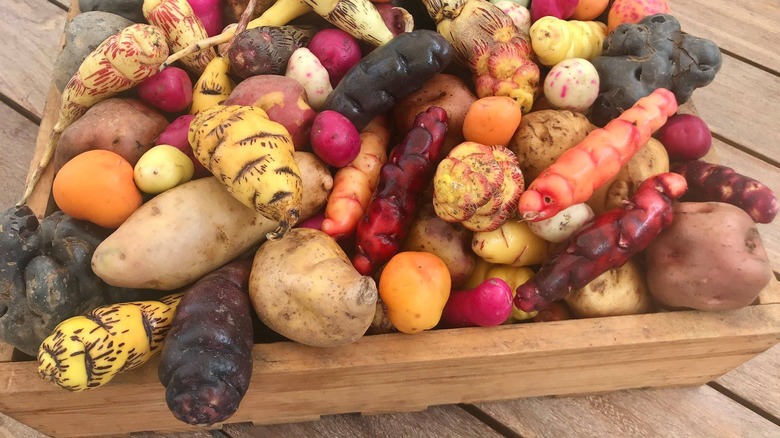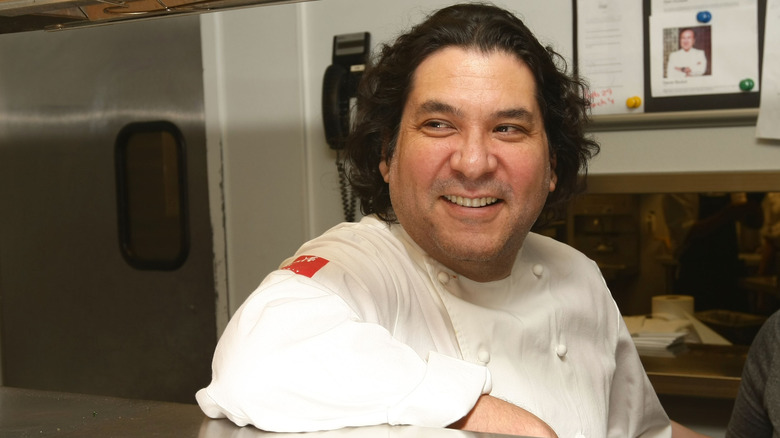The Rare Potato With Meat-Like Flesh
Potatoes are one of the most popular vegetables in the world. From tater tots to latkes, waffle fries to pierogi, potatoes dominate the culinary landscape. Though they are important to food cultures everywhere, potatoes originate in the Americas and hold exceptional cultural significance for the indigenous peoples who originally cultivated them.
Potato domestication can be traced back to around 7000 B.C.E., starting in the Andean region of South America in the highlands of Peru and Bolivia, according to academic findings in 2020 (via the National Library of Medicine). Per the International Potato Center, these ancient tubers prospered in the "cold, harsh climate and quickly took root as a centerpiece around which life revolved." Over centuries of cultivation, the Andes became home to over 4,000 varieties of native potatoes of all different kinds of tastes, textures, sizes, and colors.
As a way of celebrating and honoring the vast assortment of native produce, Peruvian chef and social activist Gaston Acurio dedicated his career years ago to popularizing Peruvian gastronomy internationally, which includes campaigning for the continued cultivation of native ingredients (via Fine Dining Lovers). Back in 2015, while promoting the plethora of Peru's endemic crops, Acurio gave his endorsement to one particularly unique type of potato — the yawar potato — which may have you questioning if it's a plant at all.
The yawar potato is a spud above others
Generally speaking, the yawar potato is typically long with dark burgundy skin and flesh so eerily similar to a fresh wound that it gets its name from the Quecha word for blood (via Fine Dining Lovers). Its flavor profile is slightly acidic (given the yawar potato's high content of zinc, iron, and additional vitamins and minerals), and has what many call a floury consistency. The latter makes these potatoes ideal for boiling in soups and stews, according to the Slow Food Foundation for Biodiversity.
In an effort to catalog and conserve the biodiversity of Andean tubers, one research group ran a compositional analysis on a handful of Peruvian potatoes and found great variability in minerals and nutritional content between the samples. Particularly, it was shown that the Yawar Manto varietal had relatively higher amounts of antioxidant compounds compared to white and yellow commercial potatoes, as did most red and purple-fleshed tubers (via the National Library of Medicine). Though these native potatoes are packed with nutrients and flavor, there is very little known about the yawar beyond the areas where they're grown. But through the efforts of activist chefs like Gaston Acurio, native ingredients around the world are finally getting recognition.
Promoting Peruvian cuisine
World-renowned chef and gastronomy pioneer Gaston Acurio (pictured above) has made it his life's work to promote the traditional ingredients and cuisines of Peruvian culture (via Fine Dining Lovers). In that vein, Acurio has been an advocate and ambassador for Peruvian cuisine on the world culinary stage for decades, but the potato has been the symbol of Peruvian national and regional identity for centuries.
As the largest potato producer in Latin America, Peru moves about 4.5 million tons of potatoes per year — but as the oldest producer of potatoes, it boasts the largest selection of potato biodiversity in the world. Among the thousands of native tubers, the yawar stands out as one of the "jewels of Peru's biodiversity" — at least in Gaston Acurio's words, pulled from a Facebook post he published in 2015.
Not only has the potato had an enormous impact on the world as a whole, but the diversity of Peruvian potatoes and the significance they hold to the farmers who grow heirloom crops is something Acurio is a strong advocate for. Though it may be some time before yawar potatoes are available internationally, this flesh-colored superfood has captured our curiosity. As chefs like Acurio continue to promote the vibrant and essential ingredients of Peru's food culture, markets will meet demands and spotlight the amazing diversity of native Peruvian potatoes.


